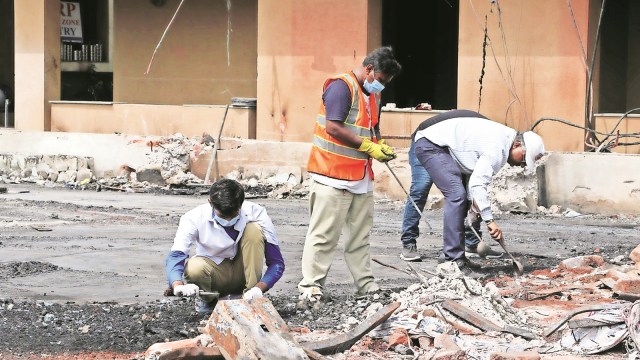Rajkot fire: Experts challenged, only 13 of 27 DNA samples identified in 2 days
The blaze that broke out on May 25 had claimed 28 lives, including seven minors. So far, the remains of all but one missing person have been found.
 Officials collect DNA samples from the accident site Monday. (File Photo)
Officials collect DNA samples from the accident site Monday. (File Photo)Two days after the Rajkot blaze, forensic experts have been able to establish identities from DNA samples of only 13 of the 27 completely charred bodies recovered from the site of the TRP Game Zone fire.
Of the 13 identified, seven bodies have been handed over to the victims’ families, Rajkot Collector Prabhav Joshi told The Indian Express. “Those remaining will be handed over in the morning as requested by the families. These have been kept in the cold room facility at the Rajkot Civil hospital and AIIMS,” Joshi said.
The seven victims whose bodies have been handed over to the families are Satyapalsinh Chhatrapalsinh Jadeja (17), Smit Manishbhai Vala, Sunilbhai Hasmukhbhai Siddhpura (45), Jignesh Kalubhai Gadhavi, Omdevsinh Gajendrasinh Gohil (35), Vishvarajsinh Jasubha Jadeja (23) and Ashaben Chandubhai Kathad (38).
DNA sampling was necessitated after the bodies were charred beyond recognition. However, according to sources, the bodies were charred to such an extent that there was no fluid remaining for even easy DNA sampling. Some of the bodies were dismembered, too, they added.
“Blood is required for extracting DNA samples from a dead body, but in the Rajkot incident, there was no blood (left in the bodies). So, the bones of the deceased were sent immediately to Gandhinagar FSL by an air ambulance to save time,” stated Minister of State for Home Harsh Sanghavi, who visited the Forensic Science Laboratory (FSL) in Gandhinagar on Monday to review the investigation.
He added that a team of more than 18 members “is working day and night to get the bodies of the deceased to their families as soon as possible”.
The blaze that broke out on May 25 had claimed 28 lives, including seven minors. So far, the remains of all but one missing person have been found.
“Some of the DNA samples have been identified today (Monday). The process of DNA analysis is underway and it is expected to confirm the remaining samples as early as possible, likely by tonight,” a senior official confirmed to The Indian Express.
According to Sanghavi, the FSL started working from 5 am Sunday. The first DNA samples to arrive were blood and post-mortem samples.
“This operation has to be done in eight stages — from extracting the DNA samples to the final report. At each stage, the duration of the test is determined based on the type of the sample,” he said.
Some of the hard tissue samples are estimated to take around 36-48 hours to be identified.
In the first stage that takes around six to seven hours, the case opening process is carried out for analysis of samples for testing, the minister explained. The second step, which also takes nearly six to seven hours, involves extracting DNA from the samples.
The third step is to check the quantity and quality of the DNA. This takes around three to four hours, the minister said. “Then PCR (Polmerase Chain Reaction) of the DNA samples, i.e., DNA enrichment process is carried out under the fourth step. It is a three-four-hour process.
The fifth stage involves DNA profiling, which takes approximately eight to nine hours. The DNA profile obtained under the sixth phase is analyzed, which takes two to three hours. In addition, the interpretation of the analyzed samples is done in the seventh phase that takes around six to seven hours, and the DNA report is prepared under the final and eighth phase that takes nearly three to five hours,” Sanghavi explained.
On Sunday, Rajkot Collector Prabhav Joshi had said, “Despite some identification evidence on the bodies, like rings and bangles, the government decided on DNA analysis for scientific identification so that there is no mistake in handing over the bodies.”







